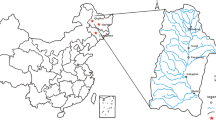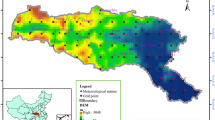Abstract
In order to explore the evolvement mechanism of hydrological elements under climate change and the interaction impacts, the hydro-meteorological elements, like temperature, precipitation, runoff, and evaporation, are studied by statistical analysis method and cause analysis approach in this paper. Initially, in terms of climate change across Anhui province, the average temperature data from 1960 to 2009 at 15 meteorological stations are selected from China Meteorological Data Sharing Network to analyze the spatio-temporal variation of temperature characteristics. Secondly, from the perspective of Xin’anjiang Basin, evolution rules of hydro-meteorological elements are studied through deviation variation of every 10 years and the long-term development trend from 1981 to 2010 at 9 hydrological stations. And the influence of climate change on runoff is analyzed according to the principle of runoff formation, and the response of runoff to precipitation and temperature is predicted with the simulating future climate change by climate models. The results show that, through statistics, the average temperature in Anhui province is in a fluctuating downward state from 1960 to 1990. After 1990, the uptrend is significant. In Xin’anjiang Basin, the annual precipitation declines overally, especially at some stations it is obvious. The variation of runoff is in a downtrend consistent with precipitation, but it is not noticeable, taken as a whole. The average evaporation changes unremarkably, except in summer and winter. Under three scenarios of A1B, A2 and B1, it is assumed that temperature, precipitation and runoff are all increasing in the future. Through cause analysis, these mainly seem to be affected by the circulation of weather background and sea surface temperature. Based on the analysis of hydro-meteorological elements under climate change and the forecasting of their future changes, the development of regional water resources can be grasped which is of great significance for human interests to water supply scheme, water conservancy project planning, and the economic-social sustainablility.












Similar content being viewed by others
References
Allen MR, Ingram WJ (2002) Constraints on the future changes in climate and the hydrological cycle. Nature 419:228–232
Cao JY, Qin DH, Luo Y et al (2007) Discharge changes of the Yangtze River in source area during 1956–2000. Adv Water Sci 18(1):29–33
Chen H, Guo SL, Xu CY et al (2007) Historical temporal trends of hydro-climatic variables and runoff response to climate variability and their relevance in water resource Management in the Hanjiang basin. J Hydrol 344:171–184
Chen J, Shi HY, Sivakumar B, Peart MR (2016) Population, water, food, energy and dams. Renew Sustain Energy Rev 56:18–28
Gago Da Silva A, Gunderson I, Goyette S, Lehmann A (2012) Delta-method applied to the temperature and precipitation time series—an example. Archive Ouverte Unige, unige-34235, pp 1–42
Gharbia SS, Gill L, Johnston P, Pilla F (2016) Multi-GCM ensembles performance for climate projection on a GIS platform. Model Earth Syst Environ 2:102
Grimm AM (2011) Interannual climate variability in South America: impacts on seasonal precipitation, extreme events, and possible effects of climate change. Stoch Environ Res Risk Assess 25(4):537–554
Houghton JT, Ding Y, Griggs DJ, Noguer M, Van Der Linden PJ, Dai X, Maskell K, Johnson CA (2001) Climate change 2001. The scientific basis. Cambridge University Press, Cambridge, p 881
IPCC (2013) Working group i contribution to the IPCC fifth assessment report, climate change: the physical science basis—summary for policymakers
Jia YW, Gao H, Niu CW et al (2008) Impact of climate change on runoff process in headwater area of the Yellow River. J Water Conserv 39(1):52–58
Kong DX, Miao CY, Wu JW, Duan QY (2016) Impact assessment of climate change and human activities on net runoff in the Yellow River Basin from 1951 to 2012. Ecol Eng 91:566–573
Li F, Xu Z, Liu W, Zhang Y (2014) The impact of climate change on runoff in the Yarlung Tsangpo River basin in the Tibetan Plateau. Stoch Environ Res Risk 28(3):517–526
Li B, Chen Y, Xiong H (2016) Quantitatively evaluating the effects of climate factors on runoff change for Aksu River in northwestern China. Theor Appl Climatol 123(1–2):97–105
Nepal S (2016) Impacts of climate change on the hydrological regime of the Koshi river basin in the Himalayan region. J Hydro-Environ Res 10:76–89
Qi DM, Li YQ, Chen YR et al (2015) Changing characteristics and cause analysis of the runoff in the source regions of the Yangtze River under the background of climate change. J Glaciol Geocryol 37(4):1075–1086
Qin D, Plattner GK, Tignor M et al (2014) Climate change 2013: the physical science basis. Cambridge University Press, Cambridge
Rehman S (2013) Long-term wind speed analysis and detection of its trends using Mann–Kendall test and linear regression method. Arab J Sci Eng 38(2):421–437
Senatore A, Mendicino G, Smiatek G, Kunstmann H (2011) Regional climate change projections and hydrological impact analysis for a Mediterranean basin in Southern Italy. J Hydrol 399(1–2):70–92
Shi HY, Wang GQ (2015) Impacts of climate change and hydraulic structures on runoff and sediment discharge in the middle Yellow River. Hydrol Process 29(14):3236–3246
Shi HY, Li TJ, Wang K, Zhang A, Wang GQ, Fu XD (2016) Physically based simulation of the streamflow decrease caused by sediment-trapping dams in the middle Yellow River. Hydrol Process 30(5):783–794
Sterk A, Schijven J, de Roda Husman AM, de Nijs T (2016) Effect of climate change on runoff of Campylobacter and Cryptosporidium from land to surface water. Water Res 95:90–102
Tursunova A (2017) The interrelation of circulation processes in the atmosphere by B. L. Dzerdzeyevskiy with the change of runoff in the basins of rivers of South Kazakhstan. Appl Water Sci 7(2):601–608
Wang Y, Liu Z, Yao J, Bayin C, Zhu Y (2018) Hydrological response of runoff to climate change of typical tributaries in Ebinur Lake Basin of Xinjiang. Water Resour 45(2):160–168
Ye L, Grimm NB (2013) Modelling potential impacts of climate change on water and nitrate export from a mid-sized, semiarid watershed in the US Southwest. Clim Change 120(1):419–431
Zeng S, Xia J, Du H (2014) Separating the effects of climate change and human activities on runoff over different time scales in the Zhang River basin. Stoch Environ Res Risk Assess 28(2):401–413
Zhang JY, Wang GQ (2007) Impact of climate change on hydrology and water resources. The Science Publishing Company, Beijing
Zhang JY, Zhang SL, Wang JX et al (2007) Study on runoff trends of the six larger basins in China over the past 50 years. Adv Water Resour 18(2):230–234
Zhang JY, Wang GQ, He RM et al (2009) Variation trends of runoffs in the middle Yellow River basin and its response to climate change. Adv Water Sci 20(2):153–158
Zhang XX, Zhang Y, Xu HJ (2013) Analysis of runoff tendency and its influencing factors in the Tao River basin from 1960 to 2010. J Lanzhou Univ (Natural Sciences) 49(1):38–43
Zhang Y, You Q, Chen C, Ge J (2016) Impacts of climate change on streamflows under RCP scenarios: a case study in Xin River Basin, China. Atmos Res 178:521–534
Zhao J, Xu J, Li X, Zhong Y, Han D, Qiu H (2017) Characteristics analysis of spatial and temporal variation on extreme weather events in Anhui Province for recent 50 years. Nat Hazards 89:817–842
Acknowledgements
The authors appreciate the support of the National Key Research and Development Program of China (Grant No. 2017YFC1502405), China Scholarship Council (Nos. 201808320128, 201808320127), the National Natural Science Foundation of China (Grant Nos. 41671022, 51609094, 51509158, 51579059), the Natural Science Foundation of Jiangsu Province for Youth (Grant No. BK20150075), Project funded by China Postdoctoral Science Foundation (Grant No. 2019M651892), Open Research Foundation for Jiangsu Key Laboratory of Agricultural Meteorology, Nanjing University of Information Science & Technology (Grant No. JKLAM1701), and Nanjing University of Information Science & Technology Research Foundation (Grant No. 2017r097). The authors also want to thank the people for their helpful suggestions and corrections on the earlier draft of our study according to which we improved the content.
Author information
Authors and Affiliations
Corresponding author
Additional information
Publisher's Note
Springer Nature remains neutral with regard to jurisdictional claims in published maps and institutional affiliations.
Rights and permissions
About this article
Cite this article
Zhao, J., Xu, J., Cheng, L. et al. The evolvement mechanism of hydro-meteorological elements under climate change and the interaction impacts in Xin’anjiang Basin, China. Stoch Environ Res Risk Assess 33, 1159–1173 (2019). https://doi.org/10.1007/s00477-019-01693-z
Published:
Issue Date:
DOI: https://doi.org/10.1007/s00477-019-01693-z




